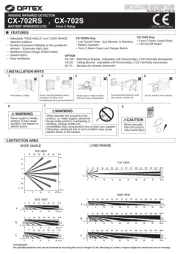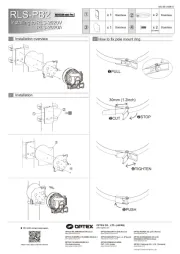Optex SL-200TNR Handleiding
Optex
Niet gecategoriseerd
SL-200TNR
Bekijk gratis de handleiding van Optex SL-200TNR (4 pagina’s), behorend tot de categorie Niet gecategoriseerd. Deze gids werd als nuttig beoordeeld door 82 mensen en kreeg gemiddeld 4.7 sterren uit 41.5 reviews. Heb je een vraag over Optex SL-200TNR of wil je andere gebruikers van dit product iets vragen? Stel een vraag
Pagina 1/4

This symbol indicates prohibition. The specific prohibited action is provided in and/or
around the figure.
Warning
Caution
Warning
Caution
INSTALLATION INSTRUCTIONS
No. 59-2032-2
FEATURES
Indicates a potentially hazardous situation which, if not avoided, will result
in minor or moderate injury, or may result in serious injury or death.
Additionally there may be significant property damage.
Indicates a potentially hazardous situation which, if not avoided, may result
in minor or moderate injury or in property damage.
• Read this instruction manual carefully prior to installation.
• After reading, store this manual carefully in an easily accessible place for reference.
• This manual uses the following warning indications for correct use of the product, harm to you
or other people and damage to your assets, which are described below. Be sure to understand
the description before reading the rest of this manual.
This symbol requires an action or gives an instruction.
This symbol indicates recommendation.
INTRODUCTION
1
1-1 BEFORE YOUR OPERATION
30m/100ft.
SL-100 TNR
60m/200ft.
SL-200 TNR
DETECTION RANGEMODEL
Do not use the product for purposes other than the detection of moving objects such as people and vehicles.
Do not use the product to activate a shutter, etc., which may cause an accident.
Do not touch the unit base or power terminals of the product with a wet hand (do not touch
when the product is wet with rain, etc.). It may cause electric shock.
Never attempt to disassemble or repair the product. It may cause fire or damage to the devices.
Do not use batteries that have different levels of power remaining (i.e., new and used batteries).
Not observing the above may result in an explosion, leakage of electrolyte, emission of toxic
gases or other outcomes that may be harmful to people and property.
[Handling of Batteries] Do not recharge, short circuit, crush, disassemble, exceed heat above
100°C (212°F), incinerate, or expose contents to water. Do not solder directly to the cell.
Do not pour water over the product with a bucket, hose, etc. The water may enter, which may
cause damage to the devices.
Clean and check the product periodically for safe use. If any problem is found, do not attempt to
use the product as it is and have the product repaired by a professional engineer or electrician.
BATTERY OPERATED
PHOTOELECTRIC DETECTOR
Smart Line series
BATTERY OPERATED
PHOTOELECTRIC DETECTOR
Smart Line series
™
™
1-2 PRECAUTIONS
PREPARATIONS
- 1 -
2
1-3 PARTS IDENTIFICATION
Do not install the
unit on an unstable
surface.
Do not install the pole
in a location where
sufficient stability can
not be ensured.
Do not install the unit in
trees, leaves, or other
objects that may swing
in the wind and block
the beam.
Do not install the
receiver in a
location where it is
exposed to direct
sunlight.
Do not allow the infrared
beam from a another detector
to reach the receiver.
Install the unit at a height
where an object can be
detected without fail.
The pole size should be
43 to 48 mm dia.
(1.69 to 1.89 inch dia.).
Install the unit at least 1
m (3.3 ft.) away from the
wall or fence that may be
running parallel to the
beam.
Accessories>>
Velcro tape: 1 set
U-brackets: 2Pole brackets: 2
4×20 self tapping for wall mounting
(with rubber washer): 4
M4×16 screws for pole mounting
(with rubber washer): 4
Cables: 3
Receiver
Transmitter
(another
detector)
Receiver
(another
detector)
Transmitter
1 m (3.3 ft.)
• Battery operated detector
- D size lithium battery or CR123A lithium battery (OPTION CRH-5)
• Simplified optical adjustment
- Sniper View Finder with ×2 magnification
• Avoids having to install a wireless transmitter in the photoelectric transmitter.
- IR signal transmission technology transfers the low battery signal to the receiver
•
Possible to connect the power and alarm cables to both the receiver and the transmitter or either of them
- OPTION PCU-5
• Long battery life
• Battery saving function
• Intermittent output function
• Slim body design
• Easy to see vivid interior color
for optical alignment
• IP65 waterproof structure
• Tamper function
• Indicator LED for an easy alignment
• Various options (Refer to page 4.)
(BCU-5, CRH-5, PCU-5)
Detector power source Battery type Wireless transmitter power source D-size
4 pcs.From detector battery
From independence battery
From detector battery
From independence battery
From detector battery
From independence battery
From detector battery
From independence battery
From detector battery
From independence battery
4 pcs.
–
–
2 pcs.
2 pcs.
–
–
–
–
–
–
16 pcs.
Wireless
Either Transmitter or
Receiver
Both Transmitter and
Receiver
Wired
16 pcs.
–
–
8 pcs.
8 pcs.
–
–
–
–
2 sets
2 sets
–
–
1 set
1 set
–
–
1 set
–
1 set
–
1 set
–
1 set
–
1 set
–
–
–
–
–
1 set
1 set
1 set
1 set
2 sets
2 sets
No
Need
No
Need
D size
CR123A
D size
CR123A
–
No
Need
No
Need
No
Need
CR123A CRH-5 BCU-5 PCU-5
BATTERY OPTION*
For Wireless transmitter
Main unit cover
Battery cover
Main unit Back box
Viewfinder
Optical
alignment dial
Optical lens
Battery cover
lock screw
Main unit cover
lock screw
Main unit mounting
bracket
Dip SW
(Receiver only)
* Refer to “9 OPTIONS” on page 4.
Unit: mm (inch)
141 (5.6)
35 (1.4)
47 (1.9)
Wireless transmitter size
.

- 2 -
INSTALLATION
3
Caution
3-1 SEPARATING
1
• Do not place the main
unit where it is exposed
to direct sunlight. Doing
so may cause damage to
the product.
4Remove the main unit from the back box. 5Remove the main unit mounting bracket.Remove the battery
cover. 2Remove the main unit
cover.
3-2 WALL MOUNTING
1Using a screwdriver or similar tool, break
the knockout position (×2) in the back
box as shown.
23
6Insert/replace batteries.
Disposal method for batteries
Note>>
Using Velcro tape, fix the wireless
transmitters in the back box.
For more information on wiring,
see “3-5 WIRING” on page 3.
5Attach the connectors.
• When using BCU-4 (option), refer to
BCU-4 manual.
4Mount the main unit.
7
Referring to “4 SETTING” on page 3,
perform the necessary settings.
8Close the main unit cover.
Warning
• When closing the cover, be careful that
the cables are not caught by the cover.
Caution
9Close the battery cover.
Caution
• Do not touch the optical unit
when mounting the cover.
Otherwise, the resulting shift
of the optical axis may result
in malfunction of the unit and
require readjustment.
3Remove the connectors.
Pull2 Pull2Loosen the
battery cover
lock screw.
1Loosen the
main unit cover
lock screw.
1
Velcro tape
Cut the supplied Velcro
tape to an appropriate
length and apply.
3-3 POLE MOUNTING
1Using the guide below, break the knockout positions (×2) in the back box with a screwdriver. 3Perform the wall
mounting procedure of
3 to 9 on page 2.
One detector
Two detectors in
opposing directions
Knockout position
Detector No. 1 Detector No. 2
Instruction
condition
POLE (1) -
POLE (1) POLE (2)
Caution
• If you accidentally open an
unnecessary knockout, be sure
to fill the knockout. Not doing so
may result in waterproof failure
and malfunction of the product.
Insert the two batteries into their
compartment. Ensure the positive
terminals are facing toward the front.
2
Close the battery plate. 3
Connect the CRH-5 male connectors
to the female connectors of the
battery plate.
4
1 Open the battery plate in the
direction of the arrow.
Set CR123A in the CRH-5 and insert
two CRH-5 into their compartment.
Ensure the positive terminals are
facing toward the front.
2
Close the battery plate. 3
1 Open the battery plate in the
direction of the arrow.
< When using D size battery >
< When using CR123A battery >
Mount the back box to the wall.
• Do not mix D size lithium batteries with CRH-5 batteries.
• Do not mix batteries that have different levels of power remaining (i.e., new
and used batteries or batteries of different manufacturers). Not observing
the above may result in an explosion, leakage of electrolyte, emission of
toxic gases or other outcomes that may be harmful to people and property.
Caution
• Remove all batteries prior to replacing with new ones. If this is not followed,
the low battery indicator LED will not reset and will continue to blink.
Open the screw holes from the
inside of the back box to the
outside.
Open the screw holes from the inside
of the back box to the outside.
Dispose of used batteries in accordance with local
government regulations/low and EU Battery
Directive (2006/66/EU).
Take the main unit out
of the back box.
2
1
3
Turn the optical unit
90 degrees and
loosen the screw.
1
2
Tighten the main unit fixing
screw and turn the optical unit
90 degrees.
3
1Attach the main unit
mounting bracket to the back
box.
2 Route the three connectors
of the back box through the
slits on the upper part of the
main unit.
1
3
4
Tighten the fixing screw for the battery cover.2
2
Close the battery cover.
1
Knockout position
WALL
POLE (1)
POLE (2)
Knockout position
WALL
POLE (1)
POLE (2)
4×20 self tapping
(with rubber washer)
Side wall
Distance from
the side wall:
at least 1m Pitch: 83.5 mm
For connection
to gang electric
box
1
3
4
2
3.9 VDC D size
Lithium batteries
CRH-5
3.0 VDC CR123A
1
2
3
Hook on the upper part
of the back box.
Push the lower part of
the main unit cover.
Fasten the main unit
cover lock screw.
2
1
3
2Fix the back box on the pole.
Side wall
M4×20 screw
(with rubber washer)
Pole bracket U-bracket
Distance from the side
wall: at least 1m
Pole 43 to 48 mm dia.
(1.69 to 1.89 inch dia.)
Detector
No. 1
Detector
No. 2
Just fit
Note>>
• Avoid placing the cables
in a position where they
can be caught between
the main unit and cover.

This unit used to enable
wired operation.
For more information on
connecting, see PCU-5
manual.
- 3 -
Set the voltmeter range to 5 to
10VDC and connect the voltmeter
probes and to and of
the monitor jack respectively.
1
Avoid installing the transmitter and receiver facing each other through the corner of the cover.
Refer to “1-3 PARTS IDENTIFICATION”.
(factory default)
2In doing this installation, the maximum detection
range shall be half of the original detection
range. (This is to compensate the attenuation of
beam by the corner of the cover.)
Attach the BCU-5 to the
battery plate using
double-sided adhesive tape.
• Be careful not to cover the
power/low battery indicator
LED.
• Select a location that does
not interfere with the
connector installation.
3-4 MOUNTING EXAMPLE AT PARTICULAR CASE
3-5 WIRING
Warning
• When using BCU-5 (option), be sure to
read the BCU-5 manual. Do not insert
batteries into the wireless transmitter.
Doing so may result in fire or explosion.
• To monitor low battery levels separately for the receiver and the transmitter, install a wireless transmitter in each of them. When the low
battery levels are monitored for both the receiver and transmitter centrally, install a wireless transmitter in only the receiver.
• If there is only an N.O. output on a wireless transmitter, the low battery output and tamper output cannot be used.
• The power supply can be shared between the back box and wireless transmitter by using BCU-5 (option).
• When using PCU-5 (option) with either only the transmitter or receiver, ensure the low battery signal is monitored. (Refer to PCU-5 manual.)
Note>>
SETTINGS
4
Optical alignment is an important
procedure to increase reliability.
Be sure to take alignment step
1 through 2 described below to
attain the maximum level of the
output through the monitor jack.
4-2 OPTICAL ALIGNMENT
Horizontal alignment angle Vertical alignment angle
1
2
Look into the viewfinder and perform fine alignment of the horizontal and vertical
angles using the alignment dial.
< How to look into the viewfinder >
Note>>
Caution
Alarm/Level
indicator
LED
Beam
interrupted Beam received
Adjustment
level
Monitor jack
output
Realign Fair Good Excellent
0 V 0.1 VDC 2.0 VDC 2.8 VDC
ON Fast blink Slow blink OFF
•
The Alarm/Level indicator LED is a supporting tool for easy
alignment. Be sure to perform fine alignment to ensure the
maximum output level through the monitor jack.
• The Alarm/Level indicator LED should only be used for
rough alignment. For fine or good alignment, always use
the monitor jack output level.
< Horizontal alignment >
< Vertical alignment >
< Receiver >
Fine adjustment with monitor jack
Checking the Indicator LED and
fine alignment
Checking of the illumination
< Receiver >
Note>>
• When making the adjustments by the monitor jack, be careful not to
cover the optical unit with your hand, the voltmeter pin cord, etc.
• After the rough alignment using the view
finder, check the light receiving status by
the Alarm/Level Indicator.
• After checking the receiving level of optical
axis by using the alarm indicator, make sure
to make fine alignment for both transmitter
and receiver with voltmeter until it reaches
maximum monitor output over “Good” level.
Note>>
• Do not press the tamper when you set the
DIP switches. Otherwise the settings will not
actually be changed.
Note>>
• The operation of the Alarm/Level indicator LED will not
change due to the battery saving timer setting. Whenever
the beam is interrupted, the indicator will turn ON.
Note>>
• Route the cables
through the center
hole.
Turn the horizontal
alignment dial by fingers
to make alignment
Turn the vertical
alignment dial with a
screwdriver to make
alignment
When connecting to BCU-5 (OPTION)
Receiver
Red
Black
Main unit Back box
Power
Main control
Alarm
EX EX – +
Battery
plate
Low battery
–
+
+
–
Wireless
Transmitter
Tamper
BCU-5
Battery
plate
BCU-5
Transmitter
Red
Black
Main unit
Blue
Green
Power
Main control
EX EX – +
– +
– +
Low battery
Back box
Wireless
Transmitter
Receiver
Red
Black
Main unit
Yellow
Orange
Brown
Green
Blue
Purple
Gray
Yellow
Orange
Brown
Green
Blue
Purple
Gray
Main control
Power
Alarm
COM
Low battery
Tamper
NC
NO
Wireless
Transmitter
Back box
Transmitter
Red
Black
Main unit
Green
Blue
Main control
Power
Low battery
Wireless
Transmitter
Back box
When connecting to PCU-5 (OPTION)
4-1 FUNCTIONS
Receiver
ON
1DIP SWITCH
SL-TNR
SELECTOR
POSITION
Battery saving timer switch
Beam interruption adjustment switch 1
Intermittent output function switch
Beam interruption adjustment switch 2
Caution
Receiver
BEAM INTERRUPTION ADJUSTMENT
2
BATTERY SAVING TIMER
3INTERMITTENT OUTPUT FUNCTION
4
(50 msec) (100 msec) (250 msec) (500 msec)
Typical
interruption
time setting
SELECTOR
POSITION
Running Jogging Walking Slow movement
SL-TNR
ON
SL-TNR
ON
OFF
Receiver
SL-TNR
ON
OFF
Transmitter Receiver
[ Top view ]
ex) SL-200TNR 60m/200ft. 30m/100ft.
5°
5°
90° 90°
Viewfinder
OPERATION CHECK
5
5-1 LED INDICATION
Beam Interruption
OFF
LEDDETECTOR
Receiver
Alarm/Level indicator LED (Receiver only)
Alarm/Level
indicator
LED
ON
(continue)
OFF
Beam not
received sufficiently
or
Normal
Receiver is
low battery
Transmitter is
low battery
Both Receiver
and Transmitter
are low battery
LED
BATTERY
CONDITION
Power/Low battery indicator LED
ON (continue)
• • •
• • •
• • •
• • •
• • •
Power/Low
battery indicator
LED
Normal
Receiver is
low battery
Transmitter is
low battery
Both Receiver
and Transmitter
are low battery
LED
BATTERY
CONDITION
ON (continue)
ON (continue)
Transmitter
The battery saving timer enforces 2 min intervals
between alarm outputs. If the site of security
involves a lot of traffic or in/out of people over a
detection zone, wireless transmitters may wear
out batteries quickly. The battery saving timer
cancels alarms for two minutes after the initial
output, preserving powers of wireless transmitters.
Initial setting is at 50 ms for normal
work. According to the speed of a
supposed target you select one
specific setting out of 4 steps.
Set the beam interruption
adjustment switches of the
Receiver according to the speed of
the human object to detect.
Intermittent output function enforces outputs to reset while beams
continues to be interrupted.
This function is effective if your wireless transmitters do not have
supervised features to monitor relay status.
Intermittent output function repeats alarms with intervals to let the
system be aware of interrupted status.
• Remove all batteries prior
to replacing with new
ones. If this is not
followed, the low battery
indicator LED will not reset
and continue to blink.
• Alarm output:
1 output/ 2 minutes • A
larm output: 1 output/ 1 minute
Left eye Right eye
From right side From left side
Alarm/Level
Indicator
LED
Power/Low battery
indicator LED
Through the
center hole.
Through the
center hole.
Product specificaties
| Merk: | Optex |
| Categorie: | Niet gecategoriseerd |
| Model: | SL-200TNR |
Heb je hulp nodig?
Als je hulp nodig hebt met Optex SL-200TNR stel dan hieronder een vraag en andere gebruikers zullen je antwoorden
Handleiding Niet gecategoriseerd Optex

5 Juli 2025

16 Juni 2025

27 Januari 2025

21 December 2024

5 December 2024

5 December 2024

5 December 2024

5 December 2024

5 December 2024

5 December 2024
Handleiding Niet gecategoriseerd
- APDTY
- Singer
- KTM
- Bullet
- Tamiya
- Kino Flo
- HEALTHSON
- Bezzera
- Rockboard
- SMAJAYU
- Prebena
- Dension
- Clean Air Optima
- Nubert
- Blind Spot
Nieuwste handleidingen voor Niet gecategoriseerd

15 September 2025

15 September 2025

15 September 2025

15 September 2025

15 September 2025

15 September 2025

15 September 2025

15 September 2025

15 September 2025

15 September 2025